Trees are one of the greatest assets to your Arizona yard or garden. They can add shade and make for excellent decoration. But, caring for trees can be a little tricky. The Arizona sun is harsh on trees, and the low rainfall doesn’t help. Unfortunately it’s not uncommon for properties to lose trees to the extreme heat.
Today, with our comprehensive Arizona tree care guide, we’ll cover how to care for your Arizona trees, including watering, fertilization, trimming, planting, and preventing diseases. We’ll also take a look at 5 trees in greater depth, looking at special considerations and concerns.
Table of Contents
Arizona Tree Care Guide
Watering
Watering is among the most obvious steps to tree care, but how exactly you should water, may not be so obvious. Here’s our dedicated Arizona tree water article if you’d like more detail than is provided here.
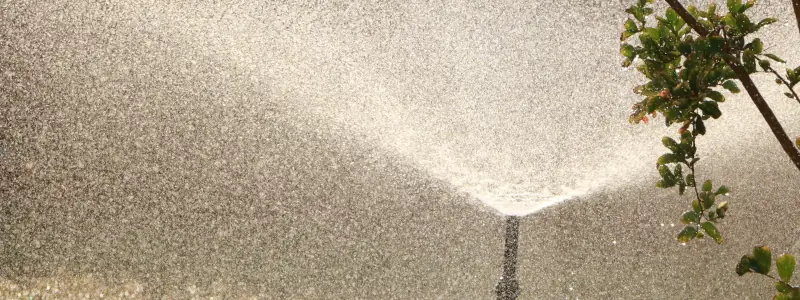
How Much Water Do I Need?
The amount of water depends on the tree’s size and species. Generally, provide 10 gallons of water per inch of trunk diameter. For example, a tree with a 2-inch trunk needs about 20 gallons per watering session. Adjust based on soil type and weather conditions.
Where Should I Water My Trees?
Water trees at the drip line, which is the area directly beneath the outer edge of the tree’s canopy. This is where the active roots are located. Avoid watering near the trunk, as this can promote root rot and fungal growth.
How Often Should I Water My Trees?
Watering frequency varies based on tree age and season. Newly planted trees need water 2-3 times per week. Established trees can be watered less frequently, typically every 1-2 weeks. During extreme heat, increase watering frequency for all trees.
For How Long Should I Be Watering?
Water slowly and deeply to encourage deep root growth. Each watering session should last long enough to moisten the soil to a depth of 3 feet. This typically takes 1-2 hours using a slow trickle from a hose or longer with drip irrigation.
Fertilizing
Proper fertilization enhances tree health and vitality in Phoenix’s challenging desert environment. It promotes stronger root systems, improved drought tolerance, and more vibrant foliage. Regular fertilization can also boost a tree’s resistance to pests and diseases, ensuring long-term survival and beauty. See our article on tree fertilization for more.
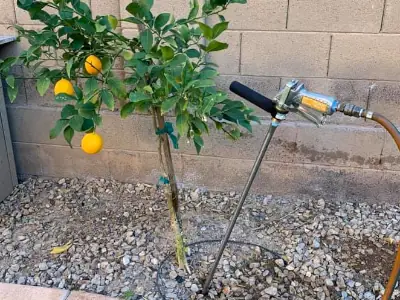
When To Apply Fertilizer
In Phoenix’s hot climate, timing fertilization is crucial. Apply fertilizer in early spring (February-March) as trees begin active growth, and again in early fall (September-October) to support root development. Avoid fertilizing during summer months when extreme heat can stress trees, potentially causing fertilizer burn or inefficient nutrient uptake.
What kind of Fertilizer is Best?
Where To Apply Fertilizer
Fertilizer should be evenly distributed around the tree’s drip line—the area directly under the outermost branches—not near the trunk. This targets the most active feeder roots. After application, the area is watered deeply to help nutrients penetrate the soil and reach the root zone. For larger trees using a fertilizer injector or creating holes around the drip line are better for nutrient distribution.
How Often Should Fertilizer Be Applied?
Trimming
We’ll cover the basic of trimming trees, for a more full explanation see our tree trimming guide.
Routine Trimming
 When routinely trimming a tree, focus on maintaining its natural shape while promoting health and structural integrity. Start by removing any dead, diseased, or damaged branches. Then, thin out dense areas to improve air circulation and light penetration. Identify and eliminate crossing or rubbing branches to prevent future damage.
When routinely trimming a tree, focus on maintaining its natural shape while promoting health and structural integrity. Start by removing any dead, diseased, or damaged branches. Then, thin out dense areas to improve air circulation and light penetration. Identify and eliminate crossing or rubbing branches to prevent future damage.
Next, address any branches that pose a safety hazard or interfere with structures or walkways. For young trees, establish a strong central leader and well-spaced scaffold branches. On mature trees, avoid removing large, healthy branches unless absolutely necessary. Always make clean cuts just outside the branch collar to promote proper healing.
Pruning Branches
Pruning branches is a tool that can be used to remove bad branches, shape trees and encourage fruit production. However, some times are better than others to prune branches. In Arizona’s hot climate, avoid pruning during the intense summer heat. The best time to prune most trees is in late winter to early spring, before new growth begins. For desert-adapted trees, prune in early spring just as new growth starts. Spring-flowering trees should be pruned immediately after blooming. Citrus trees are best pruned in late February or March. Always prune dead, diseased, or damaged branches promptly, regardless of season.
Pruning for Fruit Production
Citrus trees require light pruning to maintain an open canopy. Sunlight penetration and air circulation are essential for fruit production. Water sprouts, crossed branches, and dead wood should be removed to promote tree health. Avoid heavy pruning as it reduces fruit yield. Young trees benefit from pruning to establish a strong framework, while mature trees produce larger, higher-quality fruit when dense areas are selectively thinned. The optimal time for pruning is after fruit harvest and before spring growth begins.
Planting
Planting trees in Arizona’s unique climate requires careful consideration and preparation. The following points highlight key factors for successful tree establishment in the arid Southwest, ensuring your new trees thrive despite challenging conditions. Take a look at our tree planting article for more.
Best Time to Plant Trees in Arizona
Arizona Soil Considerations
Arizona’s soils often need improvement before planting. Amend heavy clay or sandy soils with organic matter like compost to enhance drainage, aeration, and nutrient retention. This preparation helps prevent water-logging in clay soils and excessive drying in sandy soils, creating a more hospitable environment for root development and overall tree health.
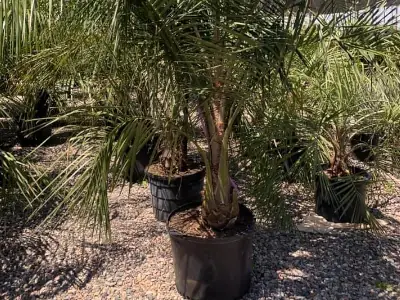
Root Depth
Watering Newly Planted Trees
Create a wide, shallow basin around the newly planted tree to contain water and ensure it reaches the roots. Water deeply but infrequently to encourage deep root growth, which improves drought tolerance. Gradually expand the watering zone as the tree grows to promote a wider root system, enhancing stability and nutrient uptake.
Disease Prevention
Maintaining healthy trees in Arizona involves vigilant pest and disease management. The harsh desert environment can stress trees, making them vulnerable to various issues. Here are crucial strategies for preventing and treating common tree problems in the region.
Proper Irrigation Strategies
Maintain consistent, deep watering schedules to prevent stress-induced susceptibility to pests and diseases. Avoid overwatering, which can lead to root rot. Use drip irrigation or soaker hoses to deliver water efficiently to the root zone, and adjust watering frequency seasonally to match the tree’s needs and local water restrictions.
Regular Inspections
Conduct thorough visual inspections of your trees at least monthly. Look for signs of pest infestation, such as chewed leaves, sticky residue, or small holes in bark. Check for disease symptoms like discolored foliage, cankers, or unusual growth patterns. Early detection allows for prompt treatment, preventing widespread damage.

Integrated Pest Management (IPM)
Implement IPM strategies to control pests and diseases while minimizing environmental impact. This approach combines biological controls (like introducing beneficial insects), cultural practices (proper pruning and sanitation), and targeted chemical treatments when necessary. Always opt for the least toxic, most effective solution for the specific problem.
Proper pruning
Maintain tree health through correct pruning practices. Remove dead, diseased, or crossing branches to improve air circulation and reduce disease spread. Prune during dormant seasons or after flowering to minimize stress. Sterilize pruning tools between cuts and trees to prevent disease transmission. Avoid over-pruning, which can weaken the tree and invite pests.
Common Arizona Trees
Mesquite Trees
Mesquite trees are hardy, drought-resistant natives of the Southwest. These versatile trees offer dense shade and produce bean pods that are both edible and nutritious. Their deep root systems help prevent soil erosion, while their ability to fix nitrogen improves soil fertility. Mesquites also provide valuable habitat for wildlife.
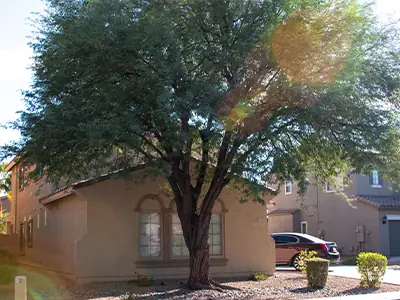
- Watering: Deep, infrequent watering to encourage deep root growth.
- Pruning: Minimal pruning for safety and aesthetics, maintaining natural form.
- Fertilizing: Rarely needed; use low-nitrogen fertilizer if necessary.
- Planting: Choose a well-draining site with full sun exposure.
- Preventing Disease: Avoid overwatering and ensure good air circulation.
Pruning
Mesquites require minimal pruning, focusing mainly on safety and aesthetics, though there are a few special concerns. Remove low-hanging branches to prevent hazards and improve visibility. Thin the canopy lightly to reduce wind resistance, but avoid over-pruning as it can lead to excessive sucker growth. Prune in late winter or early spring before new growth emerges. Always maintain the tree’s natural, multi-trunked form to preserve its distinctive character
Did You Know?
Mesquite trees offer edible pods rich in nutrients. The pods can be ground into a sweet, nutritious flour used in baking or as a sugar substitute. Native peoples have long harvested mesquite pods for food. The flowers are also edible and can be used in teas or eaten raw. Additionally, mesquite wood imparts a distinct flavor when used for smoking meats.
Palo Verde Trees
Palo Verde trees, native to the Sonoran Desert, are iconic symbols of the Arizona landscape. These striking trees are known for their green bark, which allows them to photosynthesize even when they’ve shed their tiny leaves. Palo Verdes provide dappled shade, vibrant yellow spring blooms, and serve as important nurse plants for young saguaro cacti. Their low water requirements and drought tolerance make them excellent choices for water-wise landscaping.
- Watering: Water deeply but infrequently, allowing soil to dry between waterings.
- Pruning: Light pruning to remove dead or crossing branches.
- Fertilizing: Generally unnecessary; use low-nitrogen fertilizer if needed.
- Planting: Plant in full sun with well-draining soil.
- Preventing Disease: Maintain proper watering practices to prevent root rot.
Watering
Pruning
Pruning Palo Verde trees should be done sparingly to maintain their natural, artistic form. The best time to prune is in late spring after flowering, or in early fall. Remove dead, damaged, or crossing branches to improve air circulation and structural integrity. Avoid heavy pruning, as it can stimulate excessive new growth and deplete the tree’s energy reserves. If necessary, have dense areas thinned out to enhance the tree’s sculptural appearance.
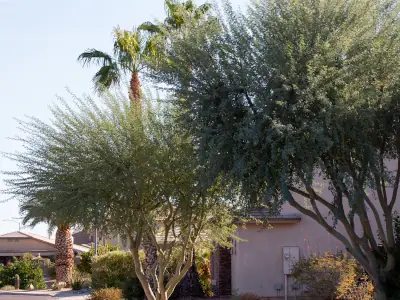
The Best Soils for Palo Verdes
Citrus Trees
Citrus trees are prized additions to Arizona landscapes, offering fragrant blossoms, ornamental value, and delicious fruits. These evergreen trees not only provide a bountiful harvest but also contribute to air purification and offer year-round greenery. Common varieties well-suited to Arizona include Valencia and Navel oranges, Meyer and Eureka lemons, Rio Red grapefruits, and Bearss limes. Each variety brings its unique flavor profile and growing characteristics to the garden.
- Watering: Frequent, shallow watering, especially during fruit development.
- Pruning: Remove water sprouts, suckers, and dead wood annually.
- Fertilizing: Apply citrus-specific fertilizer three times a year.
- Planting: Choose a sunny, protected location with well-draining soil.
- Preventing Disease: Monitor for pests and diseases regularly, ensuring good air circulation.
The Best Environments for Citrus

Citrus trees are prized additions to Arizona landscapes, offering fragrant blossoms, ornamental value, and delicious fruits. These evergreen trees not only provide a bountiful harvest but also contribute to air purification and offer year-round greenery. Common varieties well-suited to Arizona include Valencia and Navel oranges, Meyer and Eureka lemons, Rio Red grapefruits, and Bea
rss limes. Each variety brings its unique flavor profile and growing characteristics to the garden.
Fertilizing
Fertilization is essential for healthy citrus growth and fruit production. Apply a balanced, slow-release citrus fertilizer three times a year: in February, May, and September. Young trees benefit from monthly light feedings during the growing season. Always follow package instructions for application rates based on the tree’s age and size. Supplement with micronutrients, especially iron, if yellowing leaves (chlorosis) appear.
Watering
Water management is crucial for citrus trees in Arizona’s arid climate. Young trees require frequent watering, typically 2-3 times a week during their first year. As trees mature, decrease frequency but increase volume. Established trees generally need deep watering every 7-14 days in summer, extending to every 3-4 weeks in winter. Always check soil moisture before watering and adjust based on rainfall, temperature, and the tree’s age. Use a drip irrigation system or create a watering basin around the tree to ensure water penetrates deeply.
Pruning
Pruning citrus trees in Arizona is minimal compared to other fruit trees. Focus on removing dead, diseased, or crossing branches annually in late winter or early spring, before new growth begins. Avoid heavy pruning, as it can reduce fruit production and expose sensitive bark to sunburn. For size control, selectively thin out branches rather than topping the tree.
Protecting From Cold
While freezing is not a huge issue in Arizona, it does get cold enough to damage some citrus trees, especially young ones. On nights below freezing you can cover a young citrus tree in frost cloth or old bedsheets with the covering reaching to the ground to trap heat. Placing lights (so long as they aren't LEDs) can also help warm trees. Remember to remove these covers in the morning when the cold has passed.
Arizona Cypress
The Arizona Cypress (Cupressus arizonica) is a hardy, evergreen conifer native to the southwestern United States. This tree is known for its dense, pyramidal shape and attractive blue-green to silvery-gray foliage. Arizona Cypress can grow rapidly, reaching heights of 40-50 feet with a spread of 20-30 feet at maturity. Its aromatic foliage and rugged bark make it an appealing choice for both ornamental and practical landscaping purposes.
- Watering: Moderate watering, more frequent than desert-adapted species.
- Pruning: Minimal pruning required; shape as desired.
- Fertilizing: Apply slow-release fertilizer in spring if growth is slow.
- Planting: Plant in full sun or partial shade with well-draining soil.
- Preventing Disease: Avoid overhead watering to prevent fungal issues.
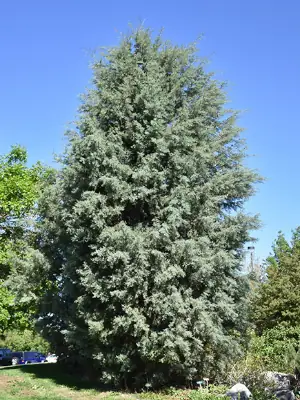
Best Places to Plant Cypresses
Watering
Arizona Cypress requires regular deep watering during its first growing season to establish a strong root system. With Cypresses you don’t have to worry as much about overwatering as other desert trees. Once established, it’s drought-tolerant and needs minimal irrigation. Water deeply but infrequently, allowing the soil to dry between waterings. In hot, dry periods, occasional deep watering benefits the tree’s health.
Pruning
Desert Willow
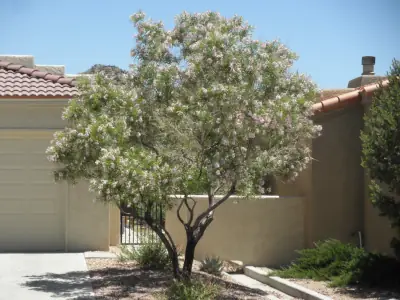
The Desert Willow (Chilopsis linearis) is a stunning, drought-tolerant tree native to the southwestern United States. Despite its name, it’s not a true willow but a member of the trumpet-vine family. This deciduous tree is prized for its long-blooming, fragrant flowers that attract hummingbirds and butterflies. Growing to 15-30 feet tall, the Desert Willow offers graceful, willow-like foliage and an open, airy canopy, making it an excellent choice for shade and ornamental purposes in arid landscapes.
- Watering: Drought-tolerant once established; water deeply and infrequently.
- Pruning: Prune in late winter to encourage dense growth and flowering.
- Fertilizing: Light fertilization in spring with a balanced, slow-release fertilizer.
- Planting: Choose a sunny location with excellent drainage.
- Preventing Disease: Ensure good air circulation and avoid overwatering.
Where Desert Willows Thrive
Watering Desert Willows
Watering requirements for Desert Willows are minimal, reflecting their natural habitat. During the first growing season, water deeply once a week to establish a strong root system. Once established, these trees are extremely drought-tolerant and only need occasional deep watering during prolonged dry spells. Overwatering can lead to root rot and must be avoided.
By choosing trees adapted to Arizona’s arid conditions and following these care guidelines, you can create a thriving, water-wise landscape. These trees not only beautify your surroundings but also provide valuable ecosystem services, from shade and wildlife habitat to improved air quality. With thoughtful selection and care, you can enjoy the numerous benefits of a vibrant tree canopy in your Arizona garden for years to come.
Alliance Manpower can meet all your tree care needs with our comprehensive service. Check out our Arizona tree care pages for more information:
Arizona Tree Care From Alliance Manpower


